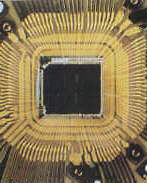gaby.de/
Computermuseum/
HP 9000/
More about the HP 9000
The HP 9000 Computer
The HP 9000 Series 520 was introduced in 1982, and described in the
August 1983 Hewlett-Packard Journal as "the new HP 9000 Computer, a
mainframe on a desktop for individual engineers and scientists." It
could run either HP BASIC, a single-user BASIC environment, or HP-UX, a
multiuser UNIX operating system with a full UNIX development
environment, including C and FORTRAN 77 compilers.
But was it really the first HP 9000? That depends on your point of
view. The HP 9000 Series 236 was available earlier, but was being sold
as the HP 9836 (with BASIC, HPL, and Pascal operating systems) and was
only later adopted into the HP 9000 product line as the HP 9000 Series
236.
The Hardware

HP 9000 Series 500 computers were based on a processor architecture
called FOCUS, comprising five NMOS-III ICs: a 32-bit segmented
stack-architecture CPU (very like the classic 16-bit HP 3000 CPU), an
I/O processor (IOP), a memory controller, a 16Kx8 dynamic RAM, and a
clock driver. HP's NMOS-III IC process allowed sufficient density and
speed that heat dissipation was a problem, and so the ICs are mounted on
special printed-circuit boards called "finstrates" -- the
printed-circuit board has a 1mm copper sheet at its core, and the IC
substrate is epoxied directly to this.
The result of this were three finstrates: CPU, IOP, and 256KB RAM. These
were installed in a 12-slot Memory/Processor Module (which is built into
the left rear of the Series 520). This permitted configurations of up
to 2.5 megabytes of RAM, and also permitted substitutions of memory
cards to construct multiprocessor systems -- up to three CPUs and two
IOPs could work together in a single system. The Memory/Processor
Module generated a 36MHz master clock that was used to drive an 18MHz
clock for the CPU; this was sufficient for each CPU to execute one
million instructions per second.
Each IOP drove an HP Channel Input-Output (CIO) bus that could support
as many as eight I/O devices. This was the first implementation of this
bus, but it was later used to support I/O in the early HP 9000 Series
800 and HP 3000 Series 900 systems. Supported I/O devices included
HP-IB interfaces, asynchronous serial interfaces, and IEEE 802.3 local
area network interfaces. On the Series 520, this bus is built into the
right rear of the base cabinet.
The HP 9000 Series 520 also had several built-in I/O devices: a display,
which could be either color or monochrome; a keyboard; a floppy-disk
drive; an optional internal thermal printer mounted below the display;
and an internal hard disk.
Plugging a 27110A/B HP-IB interface into the HP 9000 Series 500 granted
access to an array of other devices: most of the HP-IB disk, tape, and
disk/tape drives from the HP 79xx family, as well as the HP 9144
cartridge tape drive; some of the HP-IB disk drives from the HP 912x and
913x families; printers such as the HP 2934; and plotters including the
HP 74xx family. Similarly, an asynchronous serial interface granted
access to just about anything with a serial port, including terminals,
modems, printers, and plotters.
Later, a Commercial Memory Controller was developed, along with a
one-megabyte Commercial Memory finstrate. This expanded the maximum
memory configuration for the HP 9000 Series 500 to 10 megabytes, but
also required a new version of the system boot code to properly manage
Commercial Memory.
The Software
HP provided a choice of operating systems for the HP 9000 Series 520:
BASIC or HP-UX. Both of these were built on top of a common operating
system kernel, called the SUN OS (no relation to Sun Microsystems),
which provided primitives for the basic allocation and management of
memory, processor, and I/O resources. The SUN OS was not intended to be
visible to the customer, though.
HP-UX for the HP 9000 Series 500 has the distinction of being the first
commercial UNIX supporting a multi-processor system, and by the late
1980s it had become substantially similar to UNIX System V Release 2.
HP-UX provided the HP-IB interfaces with various levels of software.
For example, disk and tape drives had corresponding disk and tape
drivers, as did printers. But it also exposed the ability to construct
device files that could be used to communicate with arbitrary HP-IB
devices, and provided a library of C-callable functions for this
purpose; this allowed the system to be used for communication with
HP-IB-attached test equipment.
© Frank McConnell,
www.reanimators.org
Pictures taken from CHIP 3/1983